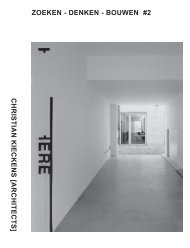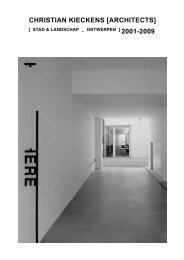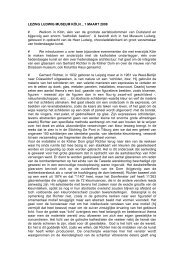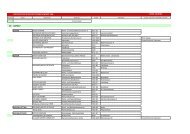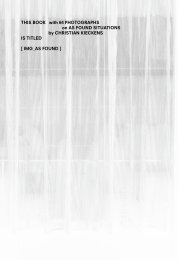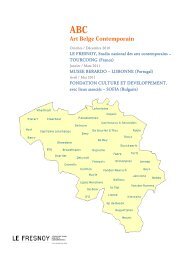download pdf - Christian Kieckens Architects
download pdf - Christian Kieckens Architects
download pdf - Christian Kieckens Architects
Create successful ePaper yourself
Turn your PDF publications into a flip-book with our unique Google optimized e-Paper software.
Wim VAN DEN BERGH<br />
Marcel MEILI<br />
_ Studied building engineering and architecture at Eindhoven University. Received the<br />
Gold Medal of the ‘Prix de Rome for Architecture’,1986. Diploma Unit Master at the<br />
Architectural Association, London [1988-93], visiting professor at the Cooper Union,<br />
New York [1992-94-97]. Head of the Academy of Architecture, Maastricht [1993-2002],<br />
professor for architectural design at Delft University [1996-99] and at Eindhoven<br />
University [1997-2001]. Guest professor at the Mackintosh School of Architecture in<br />
Glasgow and full time Professor at Aachen University. Has been dealing with Russian<br />
Avant-garde Architecture, the Idea of the Villa, the Art of Dwelling, the Museum Concept,<br />
Pataphysics, the Labyrinth and the Tower of Babel, Design as Research, Architectural<br />
Education, the De Beistigui Penthouse, the House of Curzio Malaparte, the House of<br />
K.S. Melnikov, and the work of architects like F.P.J. Peutz, John Hejduk, Dom Hans<br />
van der Laan, Raoul Bunschoten, and Luis Barragán.<br />
_ Marcel MEILI, °1953. Studies at the ETH Zürich, research fellow at the ETHZ,<br />
1981-1983. Collaboration with Dolf Schnebli, 1983-1985. Since 1987 own offices<br />
with Markus Peter in Zürich. Visiting professor at Harvard University, ETH Zürich.<br />
Since 1999 professor at the ETHZ, Studio Basel ‘Contemporary City Institute’ with<br />
Roger Diener, Jacques Herzog and Pierre de Meuron. Major projects in Aarau,<br />
Zürich, Milan and Munich.<br />
SAGA-CITY or SAGACITY ?<br />
The title is a little pun on the word sagacity and the quickness of perception<br />
that we can see in John Hejduk’s way of creating his Masques.<br />
Hejduk’s Masque projects actually are his very own personal reflections of<br />
cities.<br />
From within this hyper subjective realm of the city, in form of a Masque (a<br />
kind of architectural theater play) an idea of city emerges that has amazing<br />
powers of objectivity in terms of present day city-space and city-life.<br />
The way in which he creates the Subjects and Objects of his Masques shows<br />
another interesting aspect, which I would like to compare to what is called a<br />
doodle or doodling, the initially aimless and seemingly absentminded way of<br />
scribbling figures and designs leading to a form of serendipity in design.<br />
20<br />
A Perception of Coincidence<br />
In the history of the modern century, there is a veritable cult of coincidence<br />
that, frequently, assumes almost ethical traits. It is a matter of “things of<br />
life” that bar or impede somebody’s way, who does not expect them, or<br />
not in such a way. The power of happenstance is, so to say, the triumph of<br />
reality over the Platonic spirit such as was celebrated by Dada, Duchamp,<br />
or Cage f. i..<br />
As far as all that, the constellation is well known. Less obvious and quite<br />
exciting is what really happens, afterwards, once this coincidence breaks<br />
into our field of work: do we turn into its agent by relinquishing our status<br />
as author? Are we allowing it to “inspire” us? Are we providing chance with<br />
a gestalt and shape all its own? And if so, of what type? Or do we tidy<br />
everything up? And do we recognize this breaking-in to start with? The<br />
situation recalls Heisenberg’s uncertainty priciple: at the very moment we<br />
try and grasp this chance happening, it looses its original status. The shock<br />
of the unforeseen lasts a mere moment in time. Then the unexpected turns<br />
into the material of an inter pretation and the design into what it had been all<br />
along: a perception of reality, however on another level of complexity…<br />
I think that there are many more inconsistencies for manifold reasons<br />
between architecture and serendipity than the apology of the uncontrolled,<br />
unforeseen, and authorless would have us believe. Vice versa, the<br />
processes of manufacturing architecture are dirtier, characterized by much<br />
less sovereignty than rationalism would like us believe. In-between is a wild,<br />
untamed zone that plays a role in our own projects, too.<br />
21



